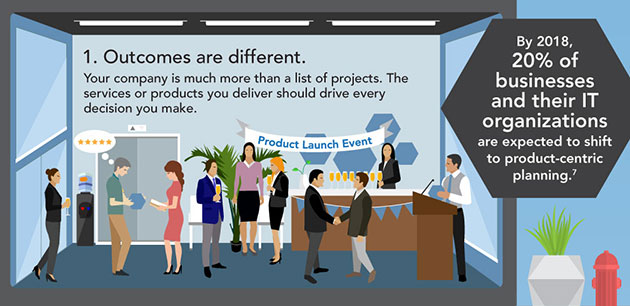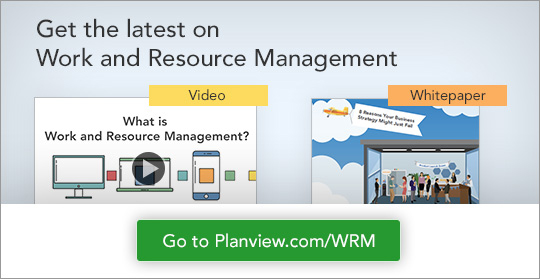
Last month I introduced the concept of Work and Resource Management as a way to deal with the complexity confronting organizations of all sizes. Eight forces are creating this complexity today, constraining the progress of organizations and teams as they try to innovate and deliver on their strategic objectives. The basic issue and opportunity here is the proliferation of work and resources, mandating a new management approach that goes beyond PPM.
Over the next several months, I’ll delve into each of these eight disruptive forces, starting with the first one:
- OUTCOMES ARE DIFFERENT
- Capabilities must be strategic
- Work methods are proliferating
- Unstructured work is exploding
- Plans are even more critical
- Teams are virtual and global
- Technology is everywhere
- Resources are multiplying
Outcomes Are Different
Here is a quick video of me explaining the significance of “outcomes are different” at our recent Horizons: The Planview Customer Conference:
The bottom line with “Outcomes are different” is that organizations can no longer define success in terms of projects alone. With the speed and agility required in today’s businesses, different groups cannot work in isolation on various projects that have little to no relation to each other or the bigger picture. What matters are the outcomes your investments deliver in pursuit of strategic objectives, in short, the end products and services.
Organizations Must Be Product-Centric
In fact, in a “Predicts 2016” report – “PPM Capabilities and Solutions Are Not Keeping Pace With Digital Transformation” – Gartner found that by 2018, 20% of businesses and their IT organizations that have shifted from project to product portfolio management will generate market leadership, driving a shift in the mainstream from project to product portfolio management.1 The report goes on to state, “IT digital consumers will expect continuous innovation and change, so PPM practitioners and solution providers must adapt.”
To adapt and become more product/service-centric, you must determine all the outcomes needed to achieve your strategic deliverables, including applications, technologies, services, solutions, products, and other essentials. Knowing this will help you break down silos and harness expertise from every area of your business. Then you can execute across business units, teams, and geographies to deliver programs, drive digital transformation, and fuel growth strategies.
For example, if you are launching a new product, what are all the outcomes needed to make this happen? Do you need to create a retail presence, an online store, create a new delivery experience, or some combination of channels? If you are a looking to improve the customer experience, what are all the outcomes required to integrate your mobile application with all other areas of the customer experience as well as your legacy IT systems?
Planview Senior Product Manager Carina Hatfield frames it nicely, “Outcomes enable ‘the what,’ so everyone can understand all aspects of what is to be delivered and how individual priorities fit in that strategic roadmap to execute across the organization.”
Why Work and Resource Management Matters
At Planview, we are helping organizations plan and execute in terms of outcomes. We define Work and Resource Management as a comprehensive category of technology capabilities that address a broader set of work and resource challenges. It serves rapid, unstructured work – such as collaborative projects and tasks – and the strategic planning and alignment of resources needed to deliver upon the strategy.
According to Ventana Research, “The work and resources of an organization should not be constrained by the boundaries of project-centric work approaches; nor should they be unstructured to the point that they are not aligned with the needs of the business’s processes or the expected outcomes of the line-of-business units.”
In this spirit, we are not only channeling the work and resource management product capabilities we currently have in Planview Enterprise, Troux, Innotas, and Projectplace; but also constantly creating new ones to help organizations exploit all these disruptive forces and realize their resource potential.
In my next post, I’ll cover why “Capabilities must be strategic.” In the meantime, for more information on Work and Resource Management, visit www.Planview.com/wrm where you will find videos, whitepapers, and analyst research related to the subject.
I’d like to hear from you. How does your organization typically plan and execute on products, services, and applications? Do you plan with the end in mind? Share by leaving a comment below.
1 & 7 Hanford, Michael; Light, Matt; Apfel, Audrey L.; Mieritz, Lars; Stang, Daniel B.; Handler, Robert A.; Schoen, Mbula; Fitzgerald, Donna; Jones, Teresa. “Predicts 2016: PPM Capabilities and Solutions Are Not Keeping Pace With Digital Transformation,” Gartner Research. Dec. 3, 2015





